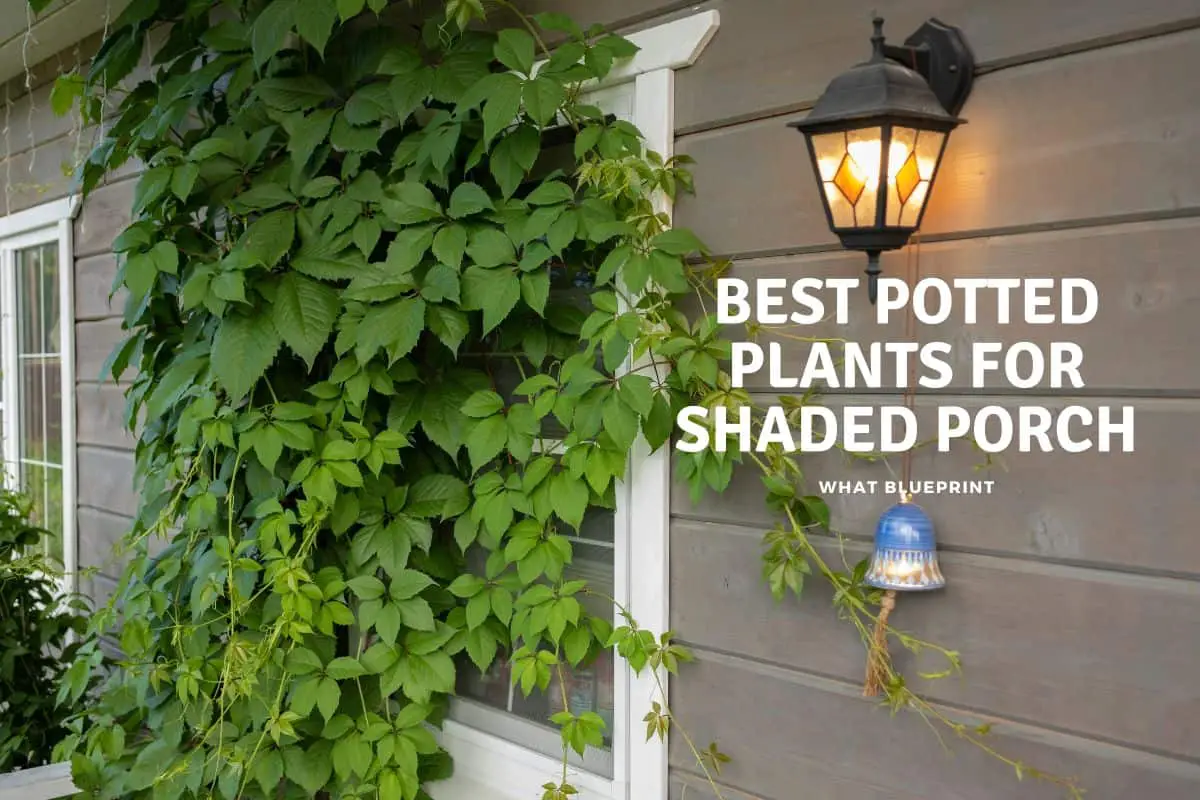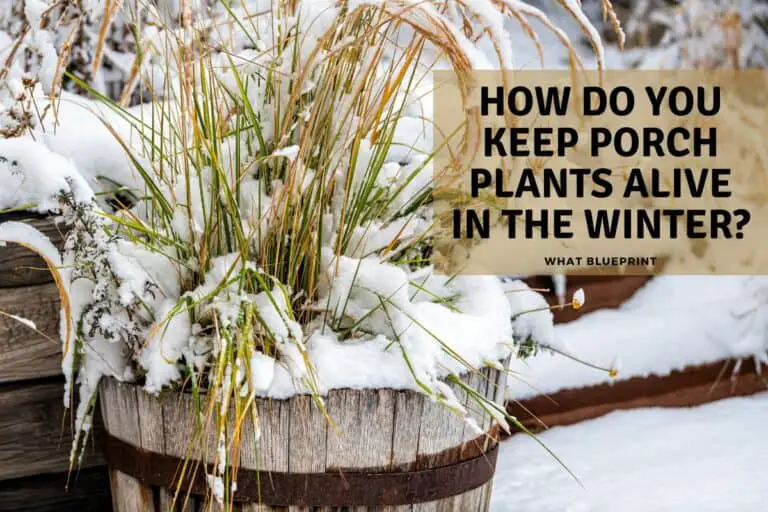Best Potted Plants For Shaded Porch
Decorate your porch with stunning plant containers in different shapes and sizes filled with various beautiful potted plants. Plants add life to a shaded porch, and lovely flowers bring splashes of vibrant color to the palette. wide-brimmed pots and fill them with plants of different heights and sizes to create a collage of varied shapes, textures, fragrances, and a kaleidoscope of beautiful colors.
If you are unsure which plants grow well in the shade, below is a list of some of best-potted potted plants for a shaded porch.
1. Hosta
Native to northeast Asia, the Hosta plant, also known as Plantain Lilies, is a shade-tolerant foliage plant. These plants have lovely leaves in various shades of green, variegated, or striped with cream or white. The leaf shapes are rounded, heart-shaped, or elongated. Dwarf varieties of Hostas reach 5 to 9 inches in height, and the taller giant types can grow to 3 feet.
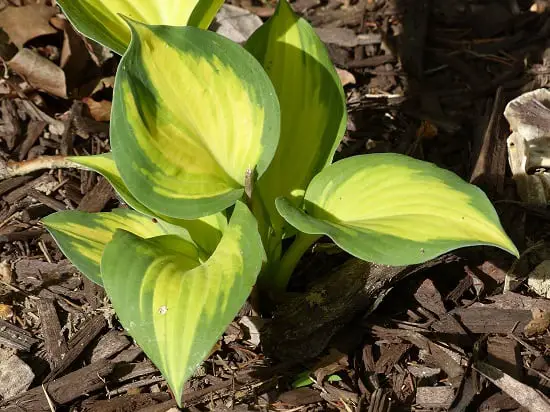
Plant the Hosta in good potting soil mixed with compost. This plant needs to be watered about twice a week, but do not water if the soil is still moist. During the growth season, fertilize the Hosta plant every three to four weeks. Hosta’s can be re-potted every three to four years or whenever it outgrows its pot and are great Potted Plants For Shaded Porches
Hosta’s will go dormant in winter, so do not water during this time. Prune the plant by cutting off the dead leaves and water the plant as it begins to revive with new growth in spring. They are great for hanging baskets on landscaped porches as well.
- Gardeners Tip – do not let water touch the leaves as it will leave marks. Instead, give the plant a good watering twice a week rather than a bit of water every day. Be sure to keep a good balance of not too dry and not too wet.
2. Begonia
Native to a sub-tropical climate, Begonias, with their lovely flowers in an assortment of colors, will brighten up any spot on your porch. There are about 2,000 species of Begonia, and most require warm temperatures to grow. All Begonias have glossy, oval-shaped leaves, grow 18 to 15 inches in height, and spread 6 to 12 inches wide.
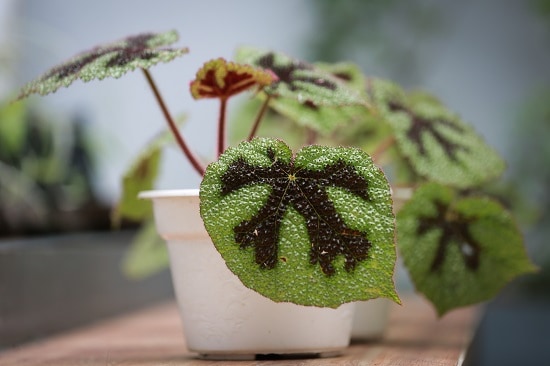
Begonias prefer to be slightly rootbound, so you could plant more than one Begonia into a large pot. Mix high-quality potting soil and compost for planting and water when the top two inches of soil have become dry.
You can fertilize Begonia’s every few weeks during the spring and summer using a balanced liquid fertilizer. Several species of Begonia go dormant while others flower throughout the winter. they look great as potted plants.
- Gardeners Tip – Begonia is sensitive to cold, so you can cut back the leaves and store the plant in a sheltered, dry area during winter. You can bring the plant outside again in the spring, give it water and fertilizer, and the Begonia will begin to grow again.
3. Hellebores
Hellebores is a beautiful, elegant, evergreen potted plants that flowers during mid to late winter, announcing that spring is on its way. The leaves are hand-shaped, and the flowers are pretty colors of cream, white, yellow, pink, and purple. Hellebores grow to 16 inches and bloom for up to 3 months. This plant is easy to grow, hardy, and withstand cold winters.
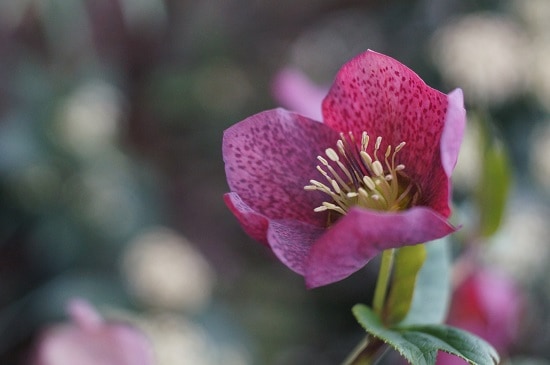
Hellebores like rich, well-drained, loamy soil with good compost and some bonemeal. This plant grows well in soil with a neutral pH. Add a balanced liquid fertilizer to the soil during the growing season. Water this plant regularly or when the top layer of soil is dry. Snip the flowers close to the bloom and float them in a bowl of water for a pretty table decoration.
- Gardeners Tip – At the end of Autumn, cut away any tattered or old leaves. This tidying up of the Hellebore will make way for new leaves and flowering stems during the winter growth period.
4. Autumn Fern (Dryopteris erythrosora)
The Autumn Fern, with its beautiful slender lacy fonds, is one of the best ferns to grow in the shade. Although a slow grower, it will reach 2 feet within a few years. The leaves are a beautiful coppery red in the spring, deepening to a bright green as the season progresses. Select a container that is tall and wide enough to accommodate the full root system of the potted plants.
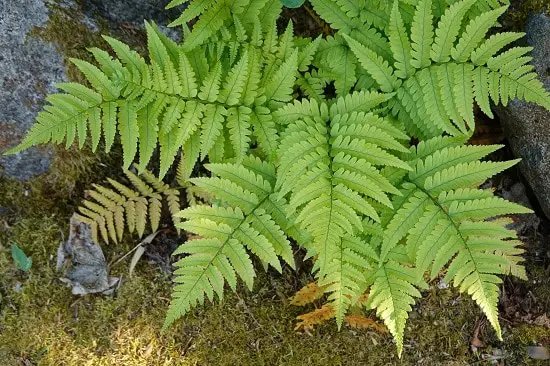
Plant this lovely fern in acidic soil (pH below 6.0) mixed with organic compost and a top layer of mulch. It is essential to always keep the soil moist, so water several times a week, especially during warm weather. Fertilize this fern once a month during the growing season. Only prune the old or dead leaves in early spring and not before the winter. Be careful not to damage new growth.
- Gardeners Tip – The potted Autumn Fern can stay outside in winter, but the plant’s roots must be protected against the cold. You can do this by wrapping the sides of the container in bubble wrap or burlap and plastic wrap.
5. Caladium Caribbean Coral (Caladium hortulanum)
Bring a tropical look to your porch by adding the gorgeous perennial Caladium Caribbean Coral planted in a lovely pot. This plant’s leaves are heart-shaped with white spots on a deep coral background with green edges. Caladiums reach a height of 15 to 20 inches and grow upright and full in containers. There are many other varieties, all with different colored leaves they look lovely as Potted Plants For Shaded Porches
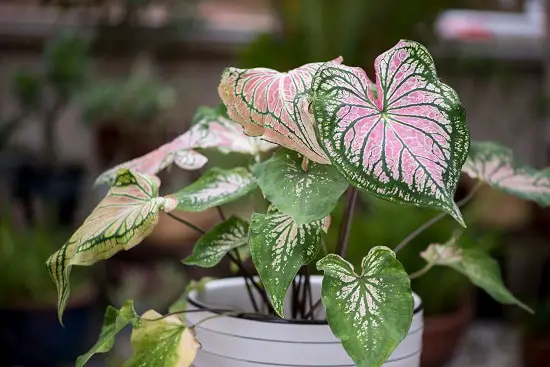
Plant your Caladium in rich potting soil mixed with peat. The pH should be slightly acidic at 5.5 to 6.2. Regular watering is this plant’s preference, so keep the soil moist and well-drained. Fertilize Caladiums with a liquid fertilizer every two weeks for strong foliage growth. You can prune this plant every 2 to 3 weeks by removing dead or damaged leaves.
- Gardeners Tip – You can leave the Caladium in its pot over winter, allow the soil to dry completely, and remove the leaves after they die. Store the pot in a cool, dark, and dry location until spring. Or you can bring the plant in its container indoors during the cold season.
6. Wild Rose Coral Bells (Heuchera hybrid)
This perennial plant has stunning bright purple leaves with deep charcoal veining. In the spring, Heuchera Wild Rose will surprise you with tall burgundy stems that sprout tiny rosy, bell-like pink flowers. These potted plants grow 8 to 10 inches in height and looks beautiful growing in a container.
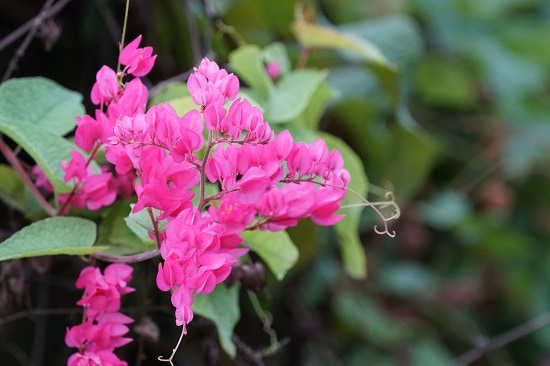
Heuchera’s like fertile soil with good drainage and neutral to slightly acidic with a pH of 6.0 to 7.0. Give the plant an inch of water once a week as the Heuchera does not tolerate soggy soil.
Heuchera plants are light feeders, so this plant only requires a slow-release fertilizer. Or you could instead blend a mix of bonemeal or alfalfa meal into the soil for extra nourishment.
- Gardeners Tip – you can leave your Heuchera plant on the porch during winter. Do not cut the plant down or trim, and you can feel if the plant is very dry, then do water it a little during the cold season. You can prune the plant in early spring at the beginning of the new growing season. The new growth will be in the center of the plant, so trim away the old outer leaves.
Plants are a lovely addition to any outdoor space you have so we have quite a few articles on how to add some greenery. These are three of the most popular articles.
7. Astilbe
Astilbes have deep green foliage with beautiful plume-shaped flowers in brilliant white, shades of pink to red, and lavender to lilac. Plant this pretty plant in spring to encourage good growth. Astilbes plants grow from 10 inches to 4 feet and make a stunning display as Potted Plants For Shaded Porches. The lovely fluffy flowers are ideal to use in flower arrangements.
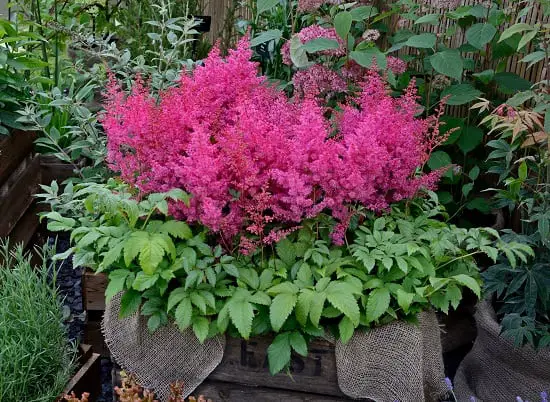
Grow the Astilbe in a good quality potting mix and make sure the pot has drainage holes. This plant likes slightly acidic soil (pH 6.0). Keep the soil damp but not soggy, so water deeply every week. You can give your Astilbe some fertilizer in the spring to aid in blooming (10-10-10).
- Gardeners Tip – during the winter, the flowers of the Astilbe will dry on the plant but will still look attractive. You can cut them off when they start to look ragged and cut back the plant in early spring to promote new growth.
8. Camellia (Camellia Spp.)
A Camellia planted in a large pot is an attractive and stunning addition to any porch. The pretty round flowers are gorgeous when in full bloom. Camellias are slow to grow and can reach 6 to 8 feet in height and 3 to 4 feet in spread. This plant blooms in late winter or spring.
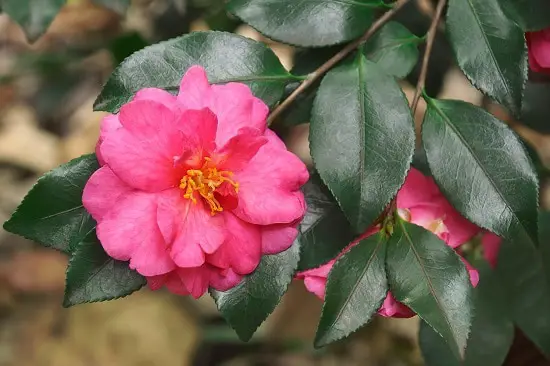
Camellias prefer well-drained, acidic soil with a pH between 5.0 and 6.5. Mix some small pine bark with equal parts of coarse sand in the pot, or you can use a good drainage potting soil. Use a container with a drainage hole. Water the Camellia deeply whenever the top 2 inches of soil feels dry, but don’t let the pot stand in water. You can fertilize these potted plants at the end of the blooming season.
- Gardeners Tip – Prune the Camellia soon after the blooming in spring. Don’t prune the plant later in the season, as this is when the new buds are forming.
9. Cappadocian Navelwort (Omphalodes Cappadocica)
For a beautiful splash of blue on your porch, fill a large, shallow container with this evergreen perennial. Omphalodes Cappadocica, commonly known as Cappadocian Navelwort, has lanceolate, green leaves which look stunning against its five-petaled, white-eyed blue flowers. Standing 6 to 9 inches tall and a 9 to 12-inch spread, this lovely plant is easy to grow.
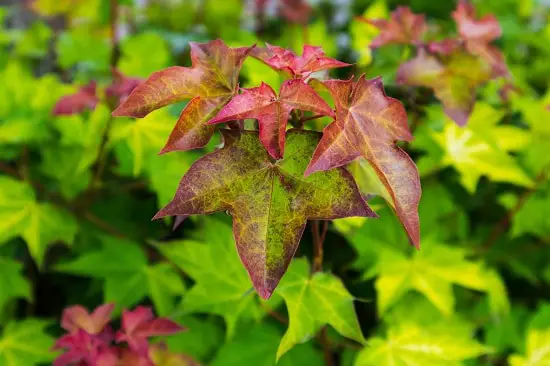
Cappadocian Navelwort grows best in fertile and well-drained soil enriched with hummus. Keep the plant well-watered and top up the soil in spring with compost or soil mix. Once a year in spring, use a nitrogen-rich fertilizer.
- Gardeners Tip– Bring your potted Cappadocian Navelwort inside during winter or leave it under the shaded porch if the roots are protected from frost.
10. Impatiens
Also known as Busy Lizzie, Impatiens are annuals with bright and pretty flowers that light up shaded areas. You can fill wide pots with different colored Impatiens or plant them in baskets hanging from your porch’s ceiling. Impatiens grow to 6 to 10 inches and spread 10 to 15 inches wide.
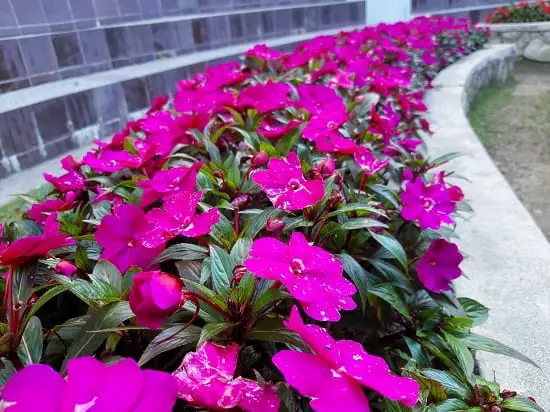
Plant Impatiens in rich, slightly acidic, and well-draining soil. You can add compost to the soil and place some mulch on top of the soil to hold in moisture. Impatiens like moist soil, so water the plant often whenever the soil feels dry. Feed your Impatiens every 2 weeks with a water-soluble fertilizer to replenish the soil and keep the plant healthy.
- Gardeners Tip – Impatiens will stop producing flowers and die back in winter. You can monitor the plant and only water when the soil is dry. Cover the plant if the temperature is very cold at night, or you could bring the plant indoors.
11. Hydrangeas
Plant your Hydrangea in a large container with drainage holes so it will have room to spread and grow and not dry out too quickly. Hydrangeas have big and beautiful flowers that add lovely colors of pink, lavender, blue, purple, and white. This attractive plant can grow to about 3 to 5 feet high and spreads about 3 feet wide.
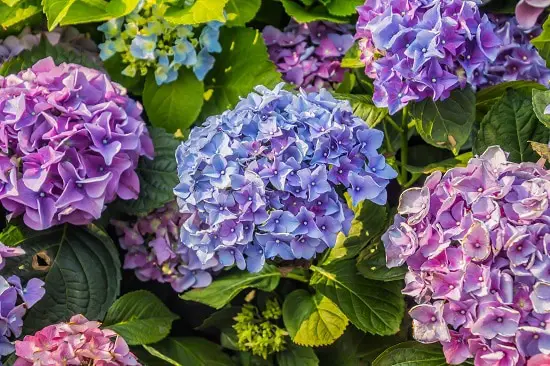
Plant the Hydrangea in good quality potting soil, and it will thrive in acidic or alkaline soil. The pH of the soil might change the color; the more acidic the soil, the Hydrangea will tend toward hues of blue or purple.
Water the plant when the soil feels dry, which could be at least 3 times per week in the summer. Feed the Hydrangea every 6 weeks with a slow-release organic fertilizer.
- Gardeners Tip – Prune the Hydrangea in late winter or early spring if they bloom on new wood. You can leave the plant on the porch during winter, but if the weather turns freezing, cover the plant and the pot.
12. Fuchsias
With its delicate and multi-colored blossoms, the Fuchsia plant looks amazing when planted upright in pots or hanging from a basket on the porch. When growing the Fuchsia as potted plants, use a container with holes to drain excess water.
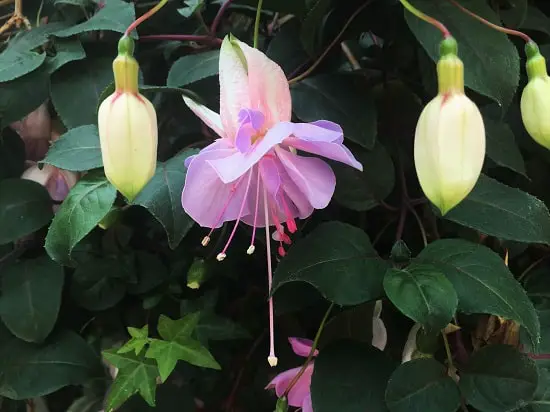
Fuchsias can reach a height of 1 to 2 feet with a similar spread. This lovely perennial has beautiful colors ranging from white to various shades of pinks and purples.Plant your Fuchsia in a good potting mix containing some leaf mold and loam to keep the soil evenly moist. Always check the soil frequently; only water when the soil is dry. Fuchsias are heavy feeders, so give the plant a liquid fertilizer every 2nd week during the growing season. You can stop fertilizing towards the end of summer to slow down growth going into winter.
- Gardeners Tip – Keep your Fuchsia in bloom by pinching or cutting back the plant. Take off about a quarter of the branch continually through late spring and summer. Pinching will force the plant to produce new growth and flowers within 6 weeks and throughout the season. Also, frequently remove dead leaves and flowers that have already bloomed.
We have loads of information and articles on plants for outdoor spaces, while a search will help checking out the articles linked below is also a good way to start.
- Best potted plants for a shaded porch
- best succulents for balconies
- low maintenance plants for balconies
- 10 tall plants for balconies
- low maintenance plants for decks
- how to keep porch plants alive in winter

